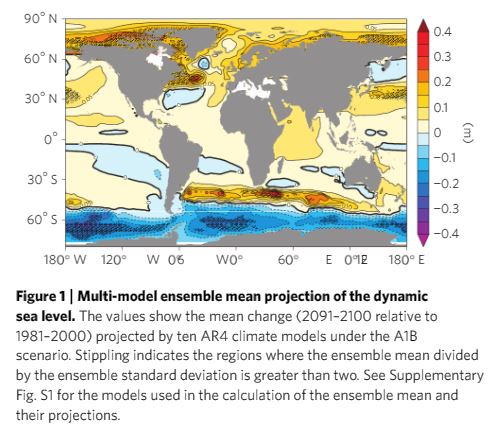Among the various en-route-to-Doomsday scenarios that may occur as we humans thoughtlessly scramble the global climate, a big one involves changing the pattern of ocean movement in the Atlantic – the Gulf Stream and other parts of the Atlantic Meridional Overturning Circulation or AMOC. This mind-bogglingly massive circulatory pattern moves heat around and creates much of what we think of as “normal” weather in North America and Europe. It is changing, partly (maybe largely) because of huge amounts of fresh water flowing off melting Greenland and Arctic ice, changing temperature, salinity and other ocean factors.
You may have heard reports this week of two studies saying the AMOC is at its slowest in centuries and probably will slow further.
One obvious result of such a change could be to make Europe’s weather more like ours, as the ocean moves less equatorial heat up north. Rome is on the same latitude as New York City but has the weather of Florida; what if it didn’t? (This is the idea behind a Victorian sci-fi story called “The White Battalion” that I read as a kid; it imagines Nicaragua destroyed by a volcano; the resulting mingling of Pacific and Atlantic waters disrupts the Gulf Stream and Europe becomes Arctic.)
But there are other complications to a slowing AMOC, including this surprising one: It will raise ocean levels along the east coast of the U.S. This puzzled me, so I hunted around for an explanation and found this paper from 2009, titled “Model projections of rapid sea-level rise on the northeast coast of the United States”. I’ll admit I’m still a bit puzzled, but here’s what I think I understand:
- The ocean isn’t flat – “sea level” is not at all level around the globe due to differences in wind patterns, currents, salinity and other factors. In parts of the world, sea level is feet higher than in other places.
- Sea level is relatively low along the east coast of the U.S. due to several factors including (a) the Gulf Stream moving past us pulls water away from our shore and (b) the patterns of the AMOC mean “the entire ocean column in the northern North Atlantic is occupied by very dense sea water, thereby significantly lowering the sea level.”
- A slowing or radical change in the AMOC would undue both those factors, causing our local sea level to rise to the level that it would have been otherwise, regardless of what else happens to ocean levels.
Here’s how the paper puts it:
Model simulations suggest that a collapse of the AMOC could cause a large regional sea-level rise in the North Atlantic. … The projected ensemble mean (ten models) shows that the sea level rise during the twenty- first century is uneven, with some regions such as the northeast coast of the United States experiencing rises considerably faster and larger than the global mean. In addition, the northeast coast of the United States is a region where models agree in projecting the dynamic sea level.


 Return to the Concord Monitor
Return to the Concord Monitor